History of Volgograd
Prehistory of the founding of Volgograd
The birth of the city was given by the Volga trade route, the Don-Volga Portage and shipping on the Volga River, which began to take shape back in the 10th century, when Rus’ (in the upper Volga), Volga Bulgaria (in the Middle Volga) and Khazaria (in the Don-Volga interfluve and the lower Volga) became their main participants. The role of merchants was played by the Varangians and Arab merchants.
By the end of the 10th century, the Volga trade was disrupted due to the waves of resettlement of the Pechenegs (from the 950s), the Polovtsians (from the 1100s), the Mongol invasion (1236-1243). The Volga trade route was revived after the Mongol conquest, when the entire river was under the control of the Ulus of Jochi (the Golden Horde). Here, three trade routes from north to south and a route from east to west began to intersect. In 1260, this factor of a convenient trade location was used when Sarai Berke, the capital of the Golden Horde, was founded. It was located about 60 km from present-day Volgograd.
On the site of today’s Volgograd there was a settlement of the Golden Horde with an unknown name. Volgograd is not the successor of this settlement. It was located about 18 km north of the historical core of Volgograd and ceased to exist 200-250 years before its foundation.
In the 15th century, the Golden Horde began to disintegrate into independent khanates: Kazan, Siberian, Astrakhan, Crimean, and others. In the 16th century, the Tsardom of Russia, on the contrary, went through a period of centralization, it became stronger and conquered the khanates one after another: Kazan in 1552, Astrakhan in 1556, Siberian in 1598. At the time of the founding of Volgograd (Tsaritsyn), only the Crimean Khanate remained unconquered.
More Historical Facts…
Foundation of Volgograd
The trade route along the Volga was revived again. Russia exported timber, grain, cloth, leather, wax, and honey through Astrakhan, and imported salt, fabrics, metals, and incense. The Volga became a transit route for international trade as well. The first mention of Tsaritsyn, as a seasonal guard post on Tsaritsyno Island, reached us in a letter from the merchant Christopher Burrow, written in 1579.
In 1585-1590, voivode Grigory Zasekin founded a number of permanent fortresses with garrisons of 100-150 people along the Volda. Today, some of them are large regional centers: Volgograd (Tsaritsyn), Samara and Saratov. The Tsaritsyn fortress also controlled the eastern side of the Don-Volga Portage - the shortest (about 70 km) distance between the Don and Volga rivers. The instructions of Tsar Fyodor Ioannovich on its development date back to 1589. This year is considered the year of Volgograd’s founding.
In 1718-1720, by order of Peter I, the Tsaritsyn fortified line was built from the Volga to the Don. Until the 1750s, the Volga-Don region was a buffer zone between the provinces of the Russian Empire north of Voronezh and the nomads and khanates of the Caucasian and Central Asian regions. During this period, Tsaritsyn remained a border settlement with military-administrative functions: supply depots for the waterway, quarantine of sick people from passing ships, and small trade. The main population was the military - up to 400 people, and a small number of civilians.
After the reforms of Peter the Great and the formation of the Russian Empire, Russian expansion into the Crimea, the Caucasus and Central Asia began. The year 1775 can be considered a new stage in the development of Tsaritsyn, when the Tsaritsyn fortified line and the Volga Cossack army were abolished and the Azov-Mozdok fortified line took over the function of the southern border of the country.
Volgograd in the 19th century
In 1820, a new urban development plan of Tsaritsyn was approved without a fortress wall and ramparts. From this period, the settlement of the adjacent territory by peasants from the central provinces began. In addition to Russians, German colonists settled here, invited by Catherine the Great. They brought with them new technologies and a new way of life.
The first school, pharmacy, coffee shop, the first planting of potatoes, mustard and tobacco in the Tsaritsyn region took place in the German colony of Sarepta-on-Volga, located 30 kilometers south of Tsaritsyn. Until the middle of the 18th century, the food industry developed primarily in Tsaritsyn, which was facilitated by the proximity of the Elton salt mines, the fish resources of the Volga and the Caspian Sea, and melon growing.
After the abolition of serfdom in 1861, the town’s industry began to grow rapidly, which was facilitated by the factors of convenient transport - the Volga and a developed railway network, and the terrain - a flat undeveloped steppe. This made it possible to build huge industrial complexes with their own infrastructure and workers’ settlements. In May 1862, the Volga-Don railway was commissioned, which connected the Volga and Don along the shortest distance and laid the foundation for the rapid industrial growth of Tsaritsyn.
In 1880, on the site of the present Central Park of Culture and Leisure, the oil refining complex with the largest oil storage facilities in the Russian Empire was built by the company “Nobel Brothers” (it became known as the Nobel town). Tsaritsyn became an important oil hub. Here, Caspian oil was poured from river tankers into railway tank cars for transportation to the European part of the Russian Empire. The availability of crude oil gave impetus to the development of oil refining. With the assistance of the British company “Vickers”, the Tsaritsyn gun factory was built (sea and field artillery of large calibers).
By 1913, Tsaritsyn in terms of the number of residents, more than 110,000, overtook many regional centers of the Russian Empire. It was a period of rapid growth in the construction of residential, industrial, public, and entertainment buildings, hospitals, schools, hotels. The infrastructure also developed rapidly: the electric network (1880), the telephone (1885), the water supply (1890), the movie theater (1907), the city tram (1913).
Volgograd in 1917-1940
The growth of population and housing development was interrupted with the outbreak of the First World War and the subsequent Russian Civil War. Due to the presence of large-scale industry, there were significant masses of workers who sympathized with the Bolsheviks, which contributed to the rapid establishment of their power in the city. Soon Tsaritsyn became a “red” outpost in the south of Russia. Fighting in the vicinity and city limits of Tsaritsyn caused significant damage to the city economy and residents.
In 1921 and 1922, the grain harvest suffered from drought and famine struck the city. Famines had happened before, but this time the consequences were aggravated by the forcible withdrawal of grain for the needs of the Red Army and the introduction of the policy of war communism.
Foreign charitable organizations provided enormous help in saving Tsaritsyn from starvation: the American Relief Administration, the International Working Committee, the Italian and Swiss Red Cross missions. In April 1922, at the peak of the famine, they opened 853 canteens in Tsaritsyn and the province, where 668,900 people received hot meals or dry rations - about half of the total population.
Even during the battles of 1919, the Soviet government took into account that in terms of population and industry, the city had long outgrown its district status, and this year the Tsaritsyn Governorate was formed. At the end of the Civil War, a peaceful life began to improve, forced “grain surplus” appropriation and elements of war communism were canceled, economic relations began to be determined by the New Economic Policy. Agriculture and industry were actively reviving and the city restored the rate of population growth.
On April 10, 1925, during a mass renaming campaign and getting rid of everything connected with the monarchy and religion, in honor of the recognition of Stalin’s merits in the defense of the city during the Civil War, Tsaritsyn was renamed Stalingrad.
As part of the industrialization of the USSR, in Stalingrad, the State District Power Plant (1929), the Tractor Plant (1930), the Shipyard (1931), and the Hardware Plant (1932) were built in a short time. The already existing factories were included in the Stalingrad tractor and tank cluster. The Stalingrad Tractor Institute was established to train engineers and workers in 1930. Two similar clusters were deployed on the basis of the Chelyabinsk Tractor Plant and Kharkov Tractor Plant.
The Stalingrad Tractor Plant was designed according to the project of the American architect Albert Kahn, the first tractor of the plant was the STZ-1 (licensed copy of the American McCormick Deering 10/20 tractor), the first tank was the T-26 (licensed British tank Vickers Mk E). In the first half of the 1930s, Stalingrad engineers launched production of new models: the STZ-3 tractor (1937) and the legendary Soviet tank T-34 (1940).
Volgograd during and after the Second World War
From July 17, 1942 to February 2, 1943, on the outskirts of Stalingrad and in the city itself, one of the most important battles of the Second World War took place - the Battle of Stalingrad. By the number of total irrecoverable losses (killed, died of wounds in hospitals, missing), it became one of the bloodiest in the history of mankind.
Soviet soldiers - about 500,000, German soldiers - about 300,000, German allies (Italians, Romanians, Hungarians, Croats) - about 200,000 people, the number of killed city residents cannot be estimated even approximately, no less than tens of thousands. The military significance of the Soviet victory was the removal of the threat of seizure by the Wehrmacht of the Lower Volga region and the Caucasus, especially the Baku oil fields.
The damage caused by the war was enormous: 41,685 houses were destroyed (90%), only 32,181 residents of the pre-war 450,000 remained in Stalingrad (of which 30,666 were in the least affected Kirovsky district). Sapper units left for the demining of the city defused more than 300 thousand mines and 1 million shells and bombs. It was only by July 1945 that it became safe to move around the city.
After the war, it was decided to prioritize the allocation of captured German construction equipment and property to Stalingrad. For example, the children’s railway received the HF110C steam locomotives of the Wehrmacht railway troops.
A significant part of the restoration work was carried out by prisoners of war. The last of them were released in 1949, except for those with criminal sentences for personally committed war crimes. By 1949, the volume of industrial production in Stalingrad exceeded the pre-war level.
Volgograd in the second half of the 20th century and beyond
The 1950s were the heyday of Stalingrad’s architecture. In the first post-war years, the most necessary objects were rebuilt, and from the beginning of the new decade, large-scale construction of monumental buildings in the Stalinist Empire style began. In this decade, the image of Stalingrad as an exemplary socialist city was created. The entire historical center of the city, the Stalin district, was rebuilt in one style.
The Volga-Don Canal, put into operation in 1952, became another symbol of the city. After Stalin’s death in 1953, during de-Stalinization, all the monuments to Stalin were demolished, all objects named in his honor were renamed. On November 10, 1961, Stalingrad was renamed Volgograd.
By the end of the 1950s, there was a gradual rejection of the Stalinist Empire style in architecture. New buildings began to be constructed in a more functional style. To speed up the solution of the housing problem in the USSR, serial production of standard apartment buildings in the form of prefabricated panels began. Unofficially called Khrushchyovkas, they were built in large numbers in all districts and micro-districts of Volgograd without exception. Today, they constitute a huge part of the housing stock of the city.
In 1967, in memory of the Battle of Stalingrad, the memorial complex Mamayev Kurgan was built. A modern transport infrastructure began to take shape, where the main role belonged to road transport. The dismissal of Khrushchev and the beginning of Brezhnev’s rule in 1964 did not cause obvious changes in the architecture of the city. In the beginning of the 1970s, the economy of the USSR entered a period of stagnation.
In 1989, the millionth resident of Volgograd was born. September 2-3, 1989, Volgograd celebrated its 400th anniversary. Starting this year, it has become a tradition to celebrate the City Day of Volgograd on the first weekend of September.
After the collapse of the USSR in 1991, a rapid decline began in the industries of the city and its urban economy. All public construction was frozen. For a decade some objects were in a state of protracted construction.
Construction again intensified in the mid-2000s. In 2018, Volgograd hosted 4 matches of the FIFA World Cup. For this, a modern stadium “Volgograd Arena” with a capacity of 45,000 people was built.
Streets of Volgograd
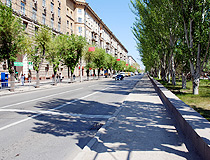
On the street in Volgograd
Author: Victor Belousov
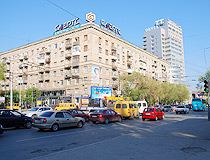
Busy intersection in Volgograd
Author: Victor Belousov
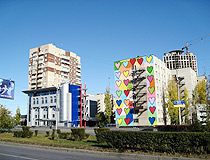
Volgograd cityscape
Author: Igor Kurylko
Volgograd - Features
Volgograd is located in the lower reaches of the Volga River on its western bank with various forms of relief. The part of the city adjacent to the Volga is low-lying, with a height of 0-40 meters above sea level, at a distance of 1-3 kilometers from the Volga there is a chain of gentle hills (50-140 meters): Mamaev Kurgan (102 meters), Lysaya Gora and others.
The city got its original name (Tsaritsyn) from the Tsaritsa River, which flows into the Volga. The name was probably based on the Tatar words “sari-su” (yellow river) or “sari-chin” (yellow island), since a Russian settlement with a wooden fortress originally arose on Tsaritsyn Island.
In 1965, after Volgograd received the status of a hero city, its coat of arms that is still in use was adopted: in the upper red field - the Star of the Hero and the battlements of the fortress wall symbolizing the Stalingrad fortress, in the lower blue field - a gear wheel and a sheaf of wheat, as symbols of advanced mechanical engineering and agriculture.
The climate in Volgograd is moderately continental. Winters are mild, with frequent thaws, summers are hot and long. In all seasons, sharp temperature changes are possible. The average temperature in February is minus 5.9 degrees Celsius, in July - plus 24.2 degrees Celsius.
After the collapse of the USSR, the industrial potential of Volgograd significantly decreased. Traffic on the Volga-Don Canal dropped significantly in 1990-2010. However, now it is close to record numbers again.
Volgograd is an important junction of highways leading to Moscow, Astrakhan, Syzran, Elista, Samara, Donetsk (Ukraine). Volgograd airport “Gumrak” is located about 20 km from the city center and offers regular flights to such cities as Moscow, St. Petersburg, Sochi, Krasnodar, Kaliningrad, Ufa, Nizhny Novgorod, and a number of others.
The specificity of the Volgograd road network comes from its unusual shape: a built-up strip with a width of 1 to 5 and a length of about 90 kilometers, in which multi-storey buildings, private residential buildings, industrial zones, and areas of undeveloped steppe alternate several times. Public transport in Volgograd is represented by buses, trams, trolleybuses, minibuses, as well as an underground high-speed tram - a kind of analogue of the metro.
Tourism in Volgograd
Today, Volgograd is quite an interesting place from a tourist point of view. Here you can see the largest river island in Europe, the only underground tram in Russia, the largest river port in Europe, and unique museums. In addition, Volgograd attracts tourists with its natural and climatic conditions and recreational resources - a huge water area, kilometers of sandy beaches and more than 200 sunny days a year.
Volgograd has the tallest sculpture-statue in Europe - the famous Motherland Calls monument, one of the largest monuments to a person who actually lived - a 57-meter-high monument to Lenin, installed at the entrance to the Volga-Don canal, the longest street in Russia - Vtoraya Prodolnaya magistral (more than 50 km), the longest residential building in the world (1,142 meters).
On the territory of Volgograd Oblast, you can visit the amazing lake of lotuses (flowering period: August-September), Lake Elton, “Volga Switzerland” - the natural park Shcherbakovsky, as well as the natural parks “Tsimlyanskie Sands”, “Donskoy”, “Nizhnekhopersky”, “Ust-Medveditskiy”, etc. Today, Volgograd is one of the twenty most popular Russian tourist destinations.
To help those traveling in the Volgograd region, there are two tourist information centers in the city. The first one is located at Gagarina Street, 12, not far from the Volgograd Planetarium, and the second - in the museum-reserve “Staraya Sarepta” (Izobilnaya Street, 10).
Traditional Volgograd souvenirs can be found in shops and kiosks on Mamayev Kurgan, in Staraya Sarepta and other museums in the city. Usually tourists buy small figurines in the form of the Motherland Monument, St. George ribbons and other items related to the glorious military past of the city.
Main Attractions of Volgograd
Mamaev Kurgan and the statue “The Motherland Calls!” In the very center of Volgograd, on the right bank of the Volga, Mamayev Kurgan (hill) rises - the place of the fiercest fighting during the Stalingrad Battle. Each of the belligerents tried at all costs to take and hold this strategically important height.
The central element of the monument-ensemble “The Heroes of the Battle of Stalingrad” on Mamayev Kurgan is the statue “The Motherland Calls!” - a grandiose statue of a woman with a sword in her hands, 85 meters high. In addition to it, the ensemble includes the Square of Those Who Fought to Death, the Hall of Military Glory with an eternal flame, Ruined Walls, the Square of Heroes, and the Square of Sorrow.
There are also several mass graves on Mamayev Kurgan, in which the ashes of more than 35 thousand defenders of Stalingrad rest. A staircase of 200 granite steps leads from the foot of the hill to its top - the number of days of the Stalingrad Battle.
Museum-Panorama “The Battle of Stalingrad”. In the 8 halls of this museum, Soviet and German weapons, military equipment, uniforms, battle flags, photographs, and documents are exhibited. The main exhibit of the museum is a huge panoramic painting “The Defeat of the German Troops in Stalingrad” devoted to the fighting for Mamayev Kurgan.
The first version of the painting was created in 1948-1950. Completed only in 1982, it became the largest battle painting in the Soviet Union. The viewers of the panorama are, as it were, on the top of Mamayev Kurgan and see all the surroundings and the events of January 26, 1943. Some of the exhibits are displayed in the open air: military equipment, several monuments. Imeni Marshala V.I. Chuykova Street, 47.
Gerhardt’s Mill. Near the museum-panorama “The Battle of Stalingrad”, you can see the ruins of a 5-storey brick building. Before the Second World War, it housed a mill that belonged to the Volga German A. Gerhardt. The war turned this building into what we see today.
Its walls are covered with traces of bullets and shell fragments, the roof and part of the ceilings have collapsed, the empty eye sockets of the windows are distorted by explosions. The building was left in a dilapidated state as a reminder of what happened here during the Second World War, as a monument to the heroism of the city’s defenders.
Fountain “Barmaley” - one of the most famous fountains in the world created on the basis of the tale of Korney Chukovsky “Barmaley” and consisting of figures of children dancing around a huge crocodile. The original fountain was created in 1930. In 2013, two replicas of the fountain were installed in its memory: near the Gerhardt’s mill and on the square near the railway station of Volgograd (Privokzalnaya Square, 1), where the original fountain once stood.
Embankment named after the 62nd Army. The central embankment of Volgograd got its name in honor of the 62nd Army, which defended the riverside during the Battle of Stalingrad. The Volgograd embankment is considered one of the most beautiful on the Volga. It consists of two levels: the first one is directly adjacent to the river, the second one runs near residential buildings. The most beautiful place on the embankment is its central stairs, built after the war and called the “front gate” of Volgograd.
Volgograd River Station - the largest river station in Russia and Europe (296 m long and 47 m high). Inside there is a concert hall for almost 1,000 spectators where organ music concerts are held. In addition, there are cafes, restaurants, a fitness center, and nightclubs. However, ships continue to dock here: a trip along the Volga River, during which you can enjoy the panoramas of Volgograd from the water, takes about one hour. Embankment of the 62nd Army Street, 6.
Pictures of Volgograd
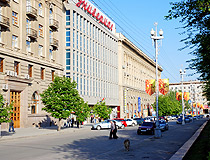
Volgograd architecture
Author: Victor Belousov
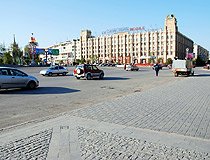
In the center of Volgograd
Author: Victor Belousov
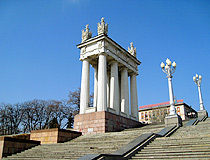
Colonnade and stairs on the central embankment of Volgograd
Author: Igor Kurylko
Pavlov’s House - a residential building famous for the fact that during the Battle of Stalingrad a group of Soviet fighters defended it for 58 days. The soldiers were led by senior sergeant Yakov Pavlov, hence the name of the building. In 1985, in honor of the 40th anniversary of the Victory, a memorial wall was erected next to it from the original material. Lenin Square (Sovetskaya Street, 39).
Volgograd Memorial Historical Museum. The collection of this museum is exhibited in a mansion (1903) that once belonged to the Repnikov merchant family. The building itself is a valuable architectural monument constructed in the new Russian style from bright red bricks.
This museum has more than 1,000 exhibits that tell primarily about the events of 1917-1923. Here you will see paintings and graphics from the Russian Civil War, military posters and historical photographs, leaflets and rare books, collectible coins, postage stamps and postcards, household items of the early 20th century. Gogol Street, 10.
Museum of Fine Arts named after Ilya Mashkov. The collection of this art gallery has paintings of the 18th-20th centuries. The history of Russian landscape painting is well represented here. There is a separate section dedicated to the works of Volgograd painters. Lenin Avenue, 21.
Tower of the Tsaritsyn Fire Brigade. This architectural structure of the late 19th century was built in an eclectic style. It is an excellent observation deck, from a 36-meter height you can see most of the city’s streets and the Volga Hydroelectric Station. Visiting the observation deck is carried out by excursion groups from the Museum of Local Lore (Lenin Avenue, 7). Kommunisticheskaya Street, 5.
Museum-Reserve “The Old Sarepta” - an open-air museum covering an area of 5 hectares and located on the site where the German colony of Sarepta-on-Volga was located in the past, about 30 km from the center of Volgograd. The memorial complex includes 26 buildings, 23 of which are architectural monuments of federal importance. It was organized for preserving the architectural heritage of the 18th-19th centuries, as well as reviving the traditions of the peoples of the Volgograd region.
The museum collection consists of ethnographic, archaeological and artistic exhibits. On the territory of the museum there are excursion programs that will help you learn the history, culture and way of life of the people of Sarepta. Here you can also listen to organ music, visit the Mustard Museum, and other interesting exhibition halls.
Volga-Don Canal. About one kilometer from “The Old Sarepta”, you can find the arch of the first sluice of the Volga-Don Canal. This is a kind of “gate” of the canal, reminiscent of a triumphal arch. The height of the structure is 40 m. More information about the canal can be found in the nearby Museum of the History of the Volga-Don Navigable Canal.
Near the approach to the sluice, a monument to Vladimir Lenin is erected (previously there was a monument to Joseph Stalin) - the largest among the monuments to people who actually lived (57 m). On the other side of the canal there is a monument-lighthouse to the sailors of the Volga military flotilla, who defended Tsaritsyn, and later Stalingrad.
Kazan Cathedral (1896-1899) - a picturesque building constructed in the eclectic style, combining the architectural styles of different eras. Perhaps that is why it looks so festive and picturesque. In 2010, the cathedral was restored to its original appearance during the reconstruction. Lipetskaya Street, 10.
Volgograd Underground Tram. The Volgograd high-speed underground tram, also known as the metro-tram, is a unique type of urban transport. This is essentially a hybrid of a metro and a tram: most of the route of two-car trains runs underground (there are only two ground stations).
Except for Volgograd and Krivoy Rog (Ukraine), such a project was not implemented anywhere else, and therefore it became a tourist attraction of Volgograd. Today, it passes through five districts and includes 22 stations. The metro-tram of Volgograd carries over 50 million passengers annually.


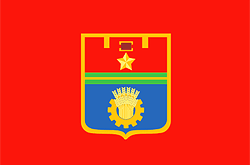
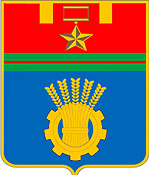
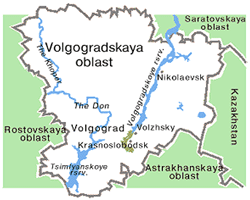






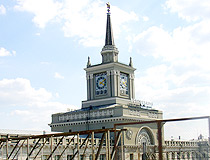
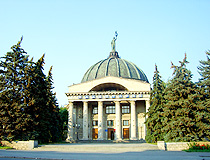
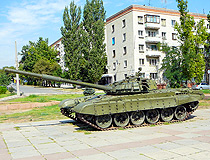
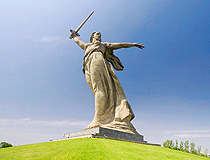
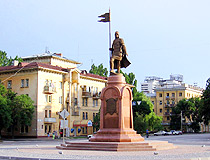
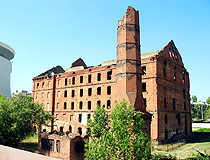
The comments of our visitors